Simultaneous Dispersive Liquid–Liquid Microextraction and Determination of Different Polycyclic Aromatic Hydrocarbons in Surface Water
Abstract
1. Introduction
2. Experiment
2.1. Reagent and Standards
2.2. Samples
2.3. Instruments
2.4. GC-MS Analysis
2.5. HPLC-FD/PDA Analysis
2.6. Extraction Procedure
3. Results and Discussion
3.1. Estimation of Effectiveness of DLLME Extraction Solvents for the Recovery of PAHs from Water
3.2. Selection of Dispersive Solvent and It Is Optimal Volume
3.3. Ultrasonication Effect on Extraction of PAHs from Water
3.4. Effect of Centrifugation on Extraction of PAHs from Water
3.5. Determination of Different PAHs by Dispersive Liquid–Liquid Microextraction and GC-MS and HPLC-FD/PDA Detection
3.6. Analytical Performance and Real Water Analysis
4. Estimation of the Extraction Effectiveness of PAHs from Waters with Different DLLME Types
5. Conclusions and Future Perspectives
Supplementary Materials
Author Contributions
Funding
Institutional Review Board Statement
Informed Consent Statement
Data Availability Statement
Conflicts of Interest
References
- Achten, C.; Andersson, J.T. Overview of Polycyclic Aromatic Compounds (PAC). Polycycl. Aromat. Compd. 2015, 35, 177–186. [Google Scholar] [CrossRef] [PubMed]
- Environmental Protection Agency. Health Effects Assessment for Polycyclic Aromatic Hydrocarbons (PAH); EPA 540/l-86-013; Environmental Criteria and Assessment Office: Cincinnati, OH, USA, 1984; pp. 1–61.
- Jesus, F.; Pereira, L.J.; Campos, I.; Santos, M.; Ré, A.; Keizer, J.; Nogueira, A.; Gonçalves, J.M.F.; Abrantes, N.; Serpa, D. A review on polycyclic aromatic hydrocarbons distribution in freshwater ecosystems and their toxicity to benthic fauna. Sci. Total Environ. 2022, 820, 153282. [Google Scholar] [CrossRef] [PubMed]
- Zheng, B.; Wang, L.; Lei, K.; Nan, B. Distribution and ecological risk assessment of polycyclic aromatic hydrocarbons in water, suspended particulate matter and sediment from Daliao River estuary and the adjacent area, China. Chemosphere 2016, 149, 91–100. [Google Scholar] [CrossRef] [PubMed]
- Mackay, D.; Shiu, W.Y.; Lee, S.C. Handbook of Physical-Chemical Properties and Environmental Fate for Organic Chemicals; Taylor & Francis Group: Boca Raton, FL, USA, 2006; pp. 1–925. [Google Scholar]
- Mezzanotte, V.; Anzano, M.; Collina, E.; Marazzi, F.A.; Lasagni, M. Distribution and Removal of Polycyclic Aromatic Hydrocarbons in Two Italian Municipal Wastewater Treatment Plants in 2011–2013. Polycycl. Aromat. Compd. 2015, 36, 213–228. [Google Scholar] [CrossRef]
- Semenov, M.Y.; Marinaite, I.I.; Golobokov, L.P.; Khuriganova, O.I.; Khodzher, T.V.; Semenov, Y.M. Source apportionment of polycyclic aromatic hydrocarbons in Lake Baikal water and adjacent air layer. Chem. Ecol. 2017, 33, 977–990. [Google Scholar] [CrossRef]
- Huang, Y.; Sui, Q.; Lyu, S.; Wang, J.; Huanga, S.; Zhaoc, W.; Wang, B.; Xu, D.; Kong, M.; Zhang, Y.; et al. Tracking emission sources of PAHs in a region with pollution-intensive industries, Taihu Basin: From potential pollution sources to surface water. Environ. Pollut. 2020, 264, 114674. [Google Scholar] [CrossRef]
- Igwe, J.C.; Ukaogo, P.O. Environmental effects of polycyclic aromatic hydrocarbons. J. Nat. Sci. Res. 2015, 5, 2224–3186. [Google Scholar]
- Lawal, A.T. Polycyclic Aromatic Hydrocarbons. A Review. Cogent Environ. Sci. 2017, 3, 1339841. [Google Scholar] [CrossRef]
- Ahad, M.E.J.; Macdonald, R.; Parrot, J.; Yang, Z.; Zhang, Y.; Siddique, T.; Kuznetsova, A.; Rauert, C.; Galarneau, E.; Studabaker, W.; et al. Polycyclic aromatic compounds (PACs) in the Canadian environment: A review of sampling techniques, strategies and instrumentation. Environ. Pollut. 2020, 266, 114988. [Google Scholar] [CrossRef] [PubMed]
- Mojiri, A.; Zhou, J.L.; Ohashi, A.; Ozakia, N.; Kindaichi, T. Comprehensive review of polycyclic aromatic hydrocarbons in water sources, their effects and treatments. Sci. Total Environ. 2019, 696, 133971. [Google Scholar] [CrossRef]
- Zhang, Q.; Liu, P.; Li, S.; Zhang, X.; Chen, M. Progress in the analytical research methods of polycyclic aromatic hydrocarbons (PAHs). J. Liq. Chromatogr. Relat. Technol. 2020, 43, 425–444. [Google Scholar] [CrossRef]
- Temerdashev, Z.; Musorina, T.; Chervonnaya, T.; Arutyunyan, Z.V. Possibilities and Limitations of Solid-Phase and Liquid Extraction for the Determination of Polycyclic Aromatic Hydrocarbons in Environmental Samples. J. Anal. Chem. 2021, 76, 1357–1370. [Google Scholar] [CrossRef]
- Umar, K.; Yaqoob, A.A.; Ibrahim, M.N.M.; Parveen, T.; Safian, M.T. Environmental applications of smart polymer composites. Smart Polym. Nanocompos. Biomed. Environ. Appl. 2020, 15, 295–320. [Google Scholar]
- Safian, M.T.; Umar, K.; Parveen, T.; Yaqoob, A.A.; Ibrahim, M.N.M. Chapter Eight-Biomedical applications of smart polymer composites. In Smart Polymer Nanocomposites: Biomedical and Environmental Applications; Woodhead Publishing Series in Composites Science and Engineering; Elsevier Inc.: Cambridge, MA, USA, 2021; pp. 183–204. [Google Scholar]
- Hassan Mohd, F.W.; Raoov, M.; Kamaruzaman, S.; Sanagi Mohd, M.; Yoshida, N.; Hirota, Y.; Nishiyama, N.; Yahaya, N. Dispersive liquid–liquid microextraction combined with dispersive solid-phase extraction for gas chromatography with mass spectrometry determination of polycyclic aromatic hydrocarbons in aqueous matrices. J. Sep. Sci. 2018, 41, 3751–3763. [Google Scholar] [CrossRef] [PubMed]
- Temerdashev, Z.A.; Musorina, T.N.; Kiseleva, N.V.; Eletskii, B.D.; Chervonnaya, T.A. Gas chromatography–mass spectrometry determination of polycyclic aromatic hydrocarbons in surface water. J. Anal. Chem. 2018, 73, 1154–1161. [Google Scholar] [CrossRef]
- Rezaee, M.; Assadi, Y.; Hosseini, M.-R.M.; Aghaee, E.; Ahmadi, F.; Berijani, S. Determination of organic compounds in water using dispersive liquid–liquid microextraction. J. Chromatogr. A 2006, 1116, 1–9. [Google Scholar] [CrossRef]
- Berijani, S.; Assadi, Y.; Anbia, M.; Milani-Hosseini, M.R.; Aghaee, E. Dispersive liquid–liquid microextraction combined with gas chromatography-flame photometric detection: Very simple, rapid and sensitive method for the determination of organophosphorus pesticides in water. J. Chromatogr. A 2006, 1123, 1–9. [Google Scholar] [CrossRef]
- Rezaeia, F.; Bidari, A.; Birjandi, A.P.; Hosseini, M.R.M.; Assadi, Y. Development of a dispersive liquid–liquid microextraction method for the determination of polychlorinated biphenyls in water. J. Hazard. Mater. 2008, 158, 621–627. [Google Scholar] [CrossRef] [PubMed]
- Campillo, N.; Viñas, P.; Šandrejová, J.; Andruch, V. Ten years of dispersive liquid-liquid microextraction and derived techniques. Appl. Spectrosc. Rev. 2017, 52, 267–415. [Google Scholar] [CrossRef]
- Wang, Q.; Chen, R.; Shatner, W.; Cao, Y.; Bai, Y. State-of-the-art on the technique of dispersive Liquid-liquid microextraction. Ultrason. Sonochem. 2019, 51, 369–377. [Google Scholar] [CrossRef]
- Zheng, J.; Liu, B.; Ping, J.; Chen, B.; Wu, H.; Zhang, B. Vortex- and Shaker-Assisted Liquid–Liquid Microextraction (VSA-LLME) Coupled with Gas Chromatography and Mass Spectrometry (GC-MS) for Analysis of 16 Polycyclic Aromatic Hydrocarbons (PAHs) in Offshore Produced Water. Water Air Soil Pollut. 2015, 226, 318–331. [Google Scholar] [CrossRef]
- Kokosa, J.M. Chapter 16-Dispersive Liquid-Liquid Microextraction. Liquid-Phase Extraction. In Handbooks in Separation Science; Elsevier: Amsterdam, The Netherlands, 2020; pp. 473–497. [Google Scholar] [CrossRef]
- Tan, Y.H.; Chai, M.K.; Wong, L.S. A review on extraction solvents in the dispersive liquidliquid microextraction. Malays. J. Anal. Sci. 2018, 22, 166–174. [Google Scholar] [CrossRef]
- Farajzadeh, M.A.; Afshar, M.M.R.; Aghanassab, M. Deep eutectic solvent-based dispersive liquid–liquid microextraction. Anal. Methods. 2016, 8, 2576–2583. [Google Scholar] [CrossRef]
- Makos, P.; Przyjazny, A.; Boczkaj, G. Hydrophobic deep eutectic solvents as “green” extraction media for polycyclic aromatic hydrocarbons in aqueous samples. J. Chromatogr. A 2018, 1570, 28–37. [Google Scholar] [CrossRef]
- Rykowska, I.; Ziemblińska, J.; Nowak, I. Modern approaches in dispersive liquid-liquid microextraction (DLLME) based on ionic liquids: A review. J. Mol. Liq. 2018, 259, 319–339. [Google Scholar] [CrossRef]
- Jordana, A.; Gathergood, N. Biodegradation of ionic liquids—A critical review. Chem. Soc. Rev. 2015, 44, 8200–8237. [Google Scholar] [CrossRef] [PubMed]
- Ma, C.; Laaksonen, A.; Liu, C.; Lu, X.; Ji, X. The peculiar effect of water on ionic liquids and deep eutectic solvents. Chem. Soc. Rev. 2018, 47, 8685–8720. [Google Scholar] [CrossRef]
- Flieger, J.; Flieger, M. Ionic Liquids Toxicity—Benefits and Threats. Int. J. Mol. Sci. 2020, 21, 6267. [Google Scholar] [CrossRef] [PubMed]
- Shishov, A.; Pochivalov, A.; Nugbienyo, L.; Andruch, V.; Bulatov, A. Deep eutectic solvents are not only effective extractants. Trends Analyt. Chem. 2020, 129, 115956. [Google Scholar] [CrossRef]
- Mohammadi, A.; Jahani, S.M.-M.; Kamankesh, M.; Jazaeri, S.; Eivani, M.; Esmaeili, S.; Abdi, S. Determination of Polycyclic Aromatic Hydrocarbons in Edible Oil Using Fast and Sensitive Microwave-assisted Extraction and Dispersive Liquid–Liquid Microextraction Followed by Gas Chromatography-Mass Spectrometry. Polycycl. Aromat. Compd. 2020, 40, 705–713. [Google Scholar] [CrossRef]
- Kamankesh, M.; Mohammadi, A.; Hosseini, H.; Tehrani, Z.M. Rapid determination of polycyclic aromatic hydrocarbons in grilled meat using microwave-assisted extraction and dispersive liquid–liquid microextraction coupled to gas chromatography–mass spectrometry. Meat Sci. 2015, 103, 61–67. [Google Scholar] [CrossRef] [PubMed]
- Mahmoudpour, M.; Mohtadinia, J.; Ansarin, M.; Nemati, M. Dispersive Liquid–Liquid Microextraction for HPLC-UV Determination of PAHs in Milk. J. AOAC Int. 2016, 99, 527–533. [Google Scholar] [CrossRef] [PubMed]
- Mahmoudpour, M.; Mohtadinia, J.; Mousavi, M.-M.; Ansarin, M.; Nemati, M. Application of the Microwave-Assisted Extraction and Dispersive Liquid–Liquid Microextraction for the Analysis of PAHs in Smoked Rice. Food Anal. Methods. 2017, 10, 277–286. [Google Scholar] [CrossRef]
- Temerdashev, Z.A.; Musorina, T.N.; Chervonnaya, T.A. Determination of polycyclic aromatic hydrocarbons in soil and bottom sediments by gas chromatography–mass spectrometry using dispersive liquid–liquid microextraction. J. Anal. Chem. 2020, 75, 1000–1010. [Google Scholar] [CrossRef]
- Avino, P.; Notardonato, I.; Perugini, L.; Russo, M.V. New protocol based on high-volume sampling followed by DLLME-GC-IT/MS for determining PAHs at ultra-trace levels in surface water samples. Microchem. J. 2017, 133, 251–257. [Google Scholar] [CrossRef]
- Li, L.; Han, D.; Wang, M.; Han, Y.; Yan, H. Molybdenum disulfide–hypercrosslinked polymer composite as an adsorbent for determination of polycyclic aromatic hydrocarbons in environmental water coupled with HPLC–FLD. Microchim. Acta 2020, 187, 242. [Google Scholar] [CrossRef] [PubMed]
- Guo, L.; Tan, S.; Li, X.; Lee, H.K. Fast Automated Dual-Syringe Based Dispersive Liquid-Liquid Microextraction Coupled with Gas Chromatography–Mass Spectrometry for the Determination of Polycyclic Aromatic Hydrocarbons in Environmental Water Samples. J. Chromatogr. A 2016, 1438, 1–9. [Google Scholar] [CrossRef] [PubMed]
- Yousefi, S.M.; Shemirani, F.; Ghorbanian, S.A. Hydrophobic Deep Eutectic Solvents in Developing Microextraction Methods Based on Solidification of Floating Drop: Application to the Trace HPLC/FLD Determination of PAHs. Chromatographia 2018, 81, 1201–1211. [Google Scholar] [CrossRef]
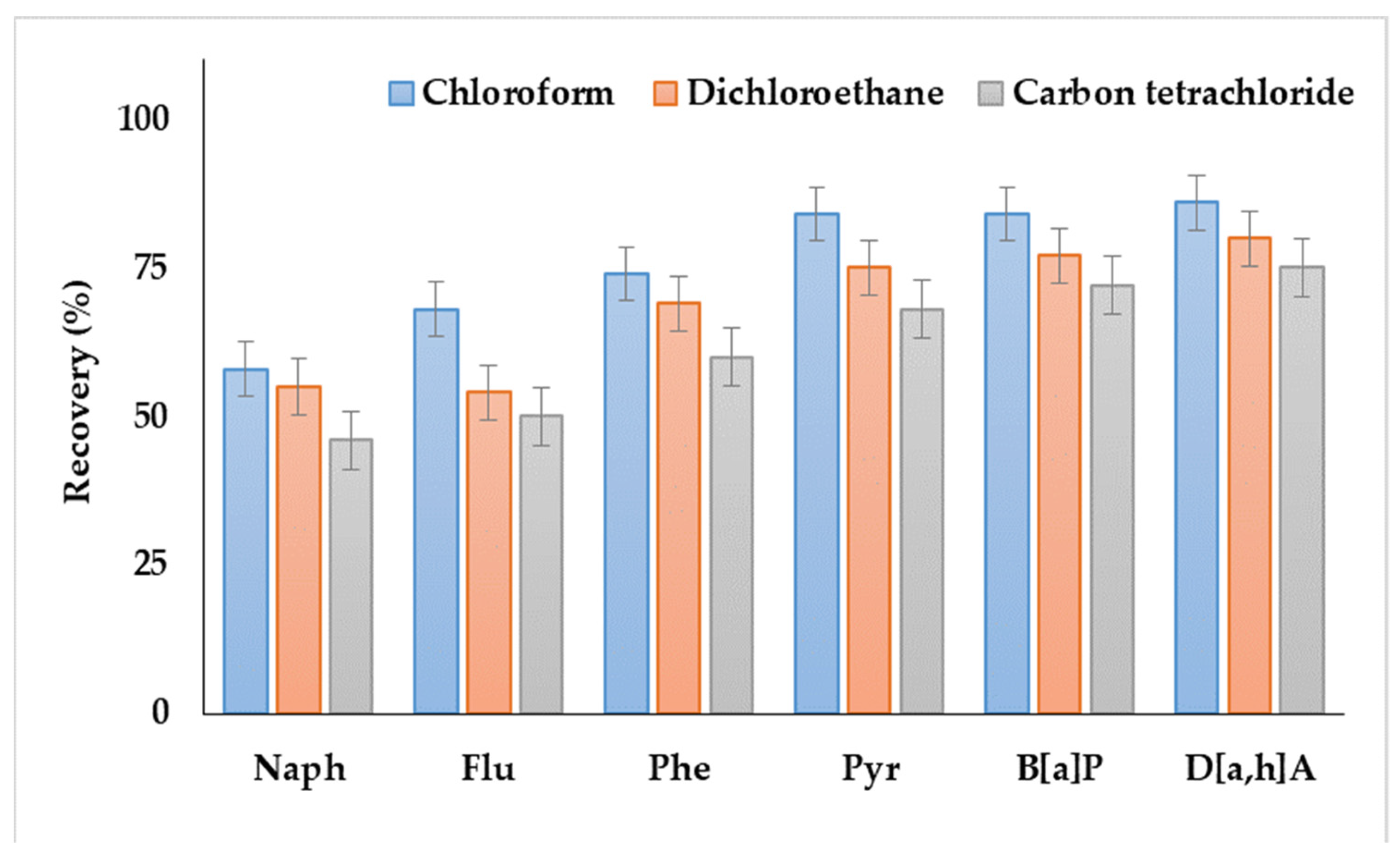

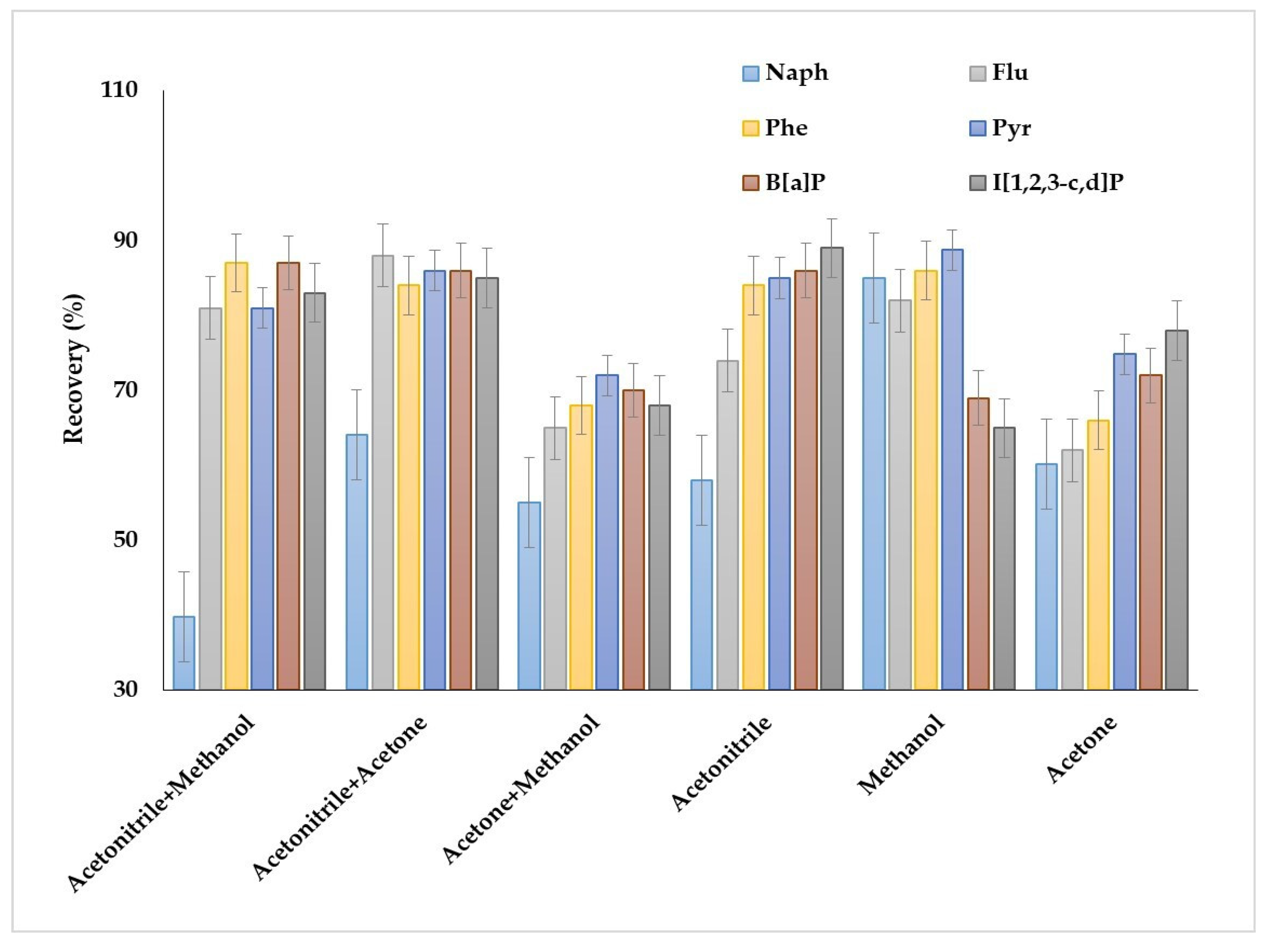
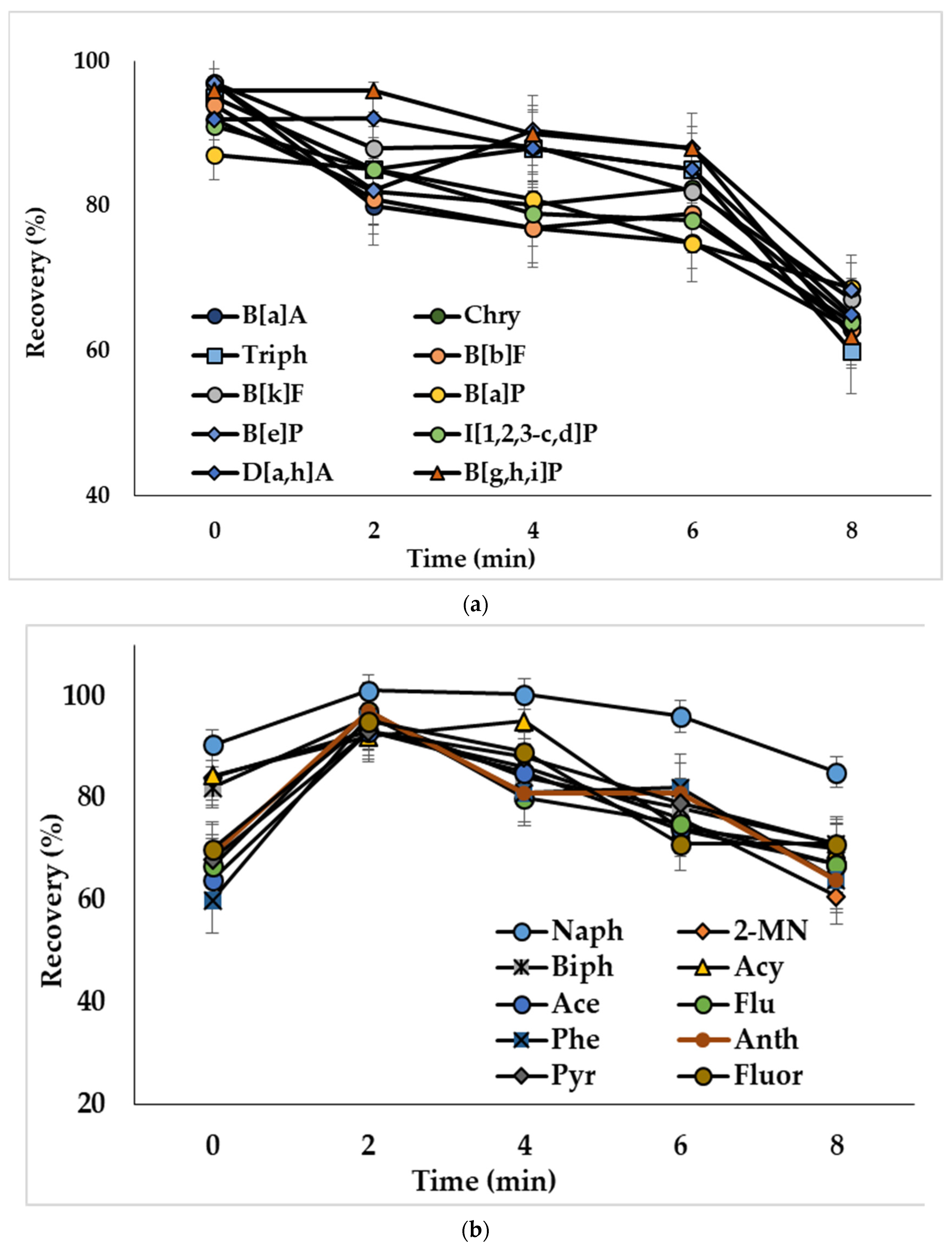
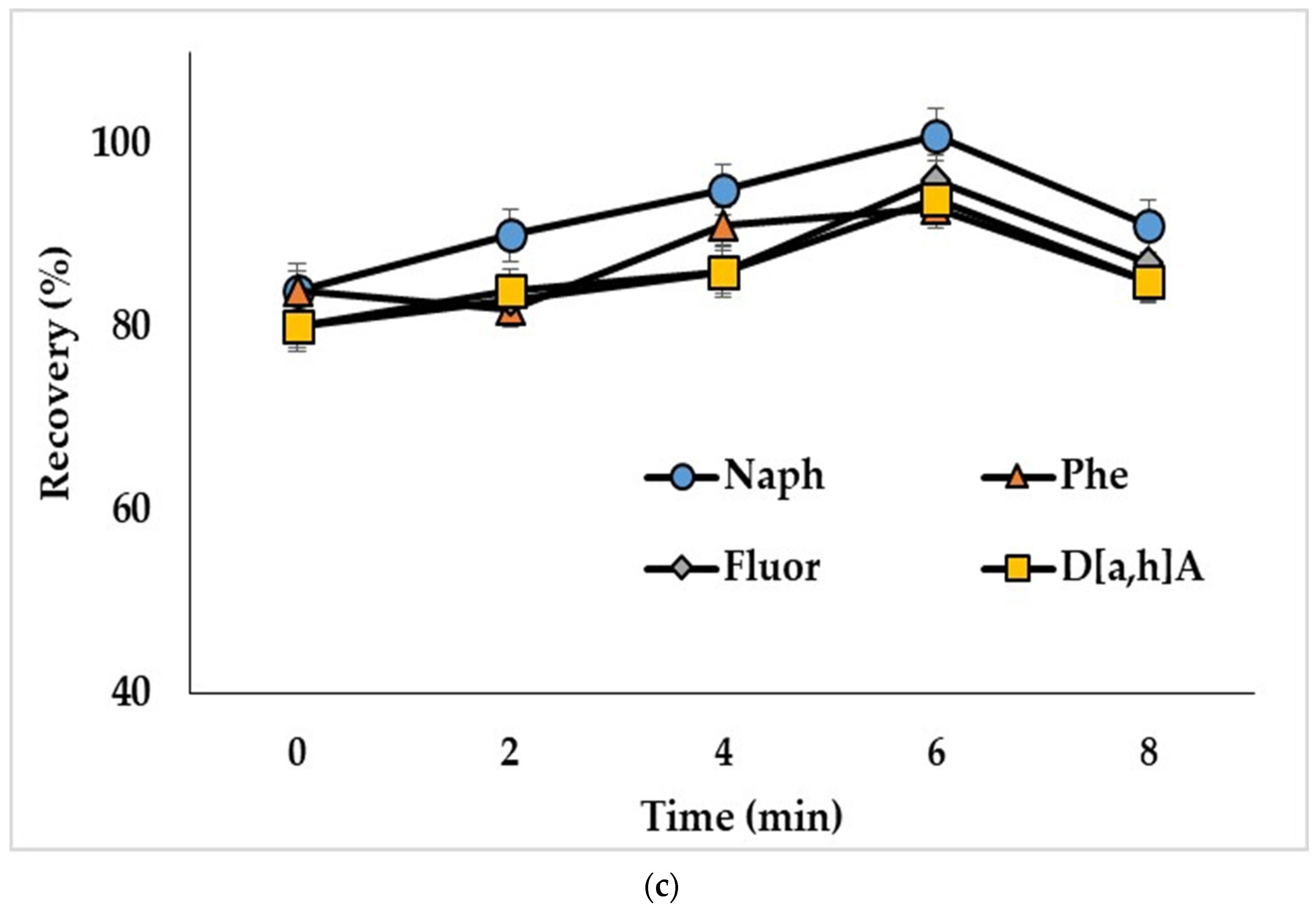
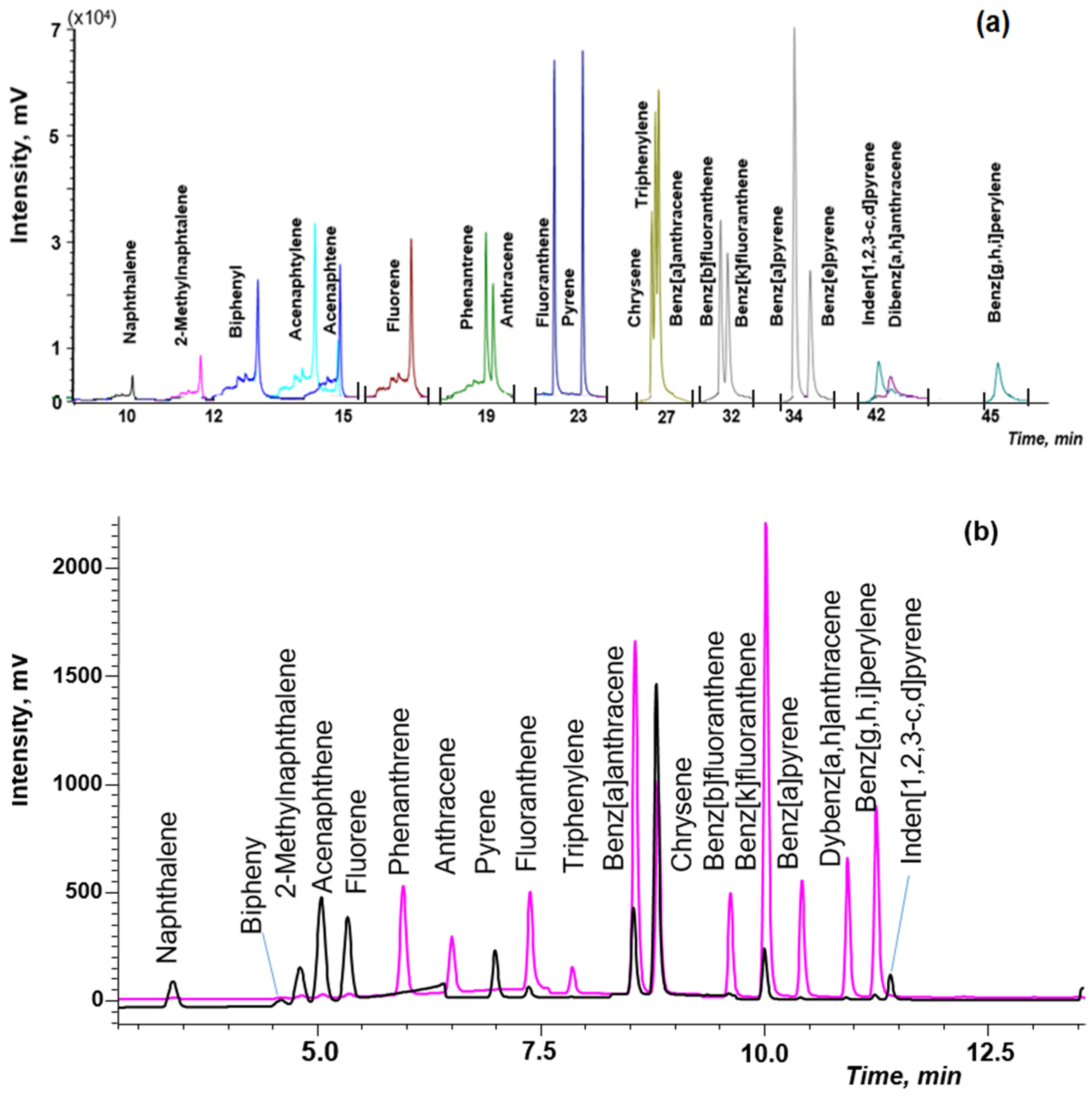
| PAHs | Mr | S, mg/L | P, Pa | Kow | Half-Life in the Environment, h | ||
|---|---|---|---|---|---|---|---|
| Light | 2 to 3 rings | Naphthalene | 128 | 31–34 | 37–42 | 3.2–3.8 | 16–6193 |
| 2-Methylnaphthalene | 142 | 20.0–27.3 | 6.3–10.7 | 3.9–4.1 | 54–9840 | ||
| Biphenyl | 154 | 7.0–7.8 | 1.3–6.9 | 3.2–4.3 | 36–336 | ||
| Acenaphthylene | 152 | 3.4–16.1 | 0.89–1.1 | 3.7–4.1 | 1020–1440 | ||
| Acenaphthene | 154 | 3.9–3.8 | 0.21–3.1 | 3.9–4.5 | 3–4896 | ||
| 3 to 4 rings | Fluorene | 166 | 1.6–1.8 | 0.08–0.79 | 3.7–4.3 | 768–2880 | |
| Phenanthrene | 178 | 1.0–1.2 | 0.02–0.11 | 4.5–4.6 | 3–9600 | ||
| Anthracene | 178 | 0.04–0.08 | 5.7 × 10−4–0.1 | 4.2–5.3 | 1–22,080 | ||
| Pyrene | 202 | 0.1–0.2 | 1.7 × 10−4–0.2 | 4.8–5.5 | 1–91,200 | ||
| Fluoranthene | 202 | 0.21 | 1.3 × 10−4–0.1 | 4.5–5.2 | 21–21,120 | ||
| Heavy | more than 4 rings | Benz[a]anthracene | 228 | 0.0090–0.0094 | 3.9 × 10−7–2.5 × 10−4 | 5.0–5.9 | 0.5–32,640 |
| Chrysene | 228 | 0.0015–0.0170 | 8.4 × 10−7–2.3 × 10−4 | 5.5–5.9 | 0.5–48,000 | ||
| Triphenylene | 228 | 0.040 | 3.9 × 10−7–1.2 × 10−2 | 4.8–6.3 | – | ||
| Benz[b]fluoranthene | 252 | 0.0011–0.0015 | 5.0 × 10−8–6.7 × 10−5 | 5.8 | 9–29,280 | ||
| Benz[k]fluoranthene | 252 | 0.0008–0.0011 | 1.3 × 10−8–6.7 × 10−5 | 5.9–7.2 | 4–102,720 | ||
| Benz[a]pyrene | 252 | 0.0016 | 7.5 × 10−7–1.1 × 10−4 | 6.0–8.0 | 0.4–25,440 | ||
| Benz[e]pyrene | 252 | 0.0001–0.0073 | 7.4 × 10−7–1.8 × 10−5 | 5.7–7.4 | – | ||
| Inden[1,2,3,-c,d]pyrene | 278 | 0.0002–0.0004 | 1.3 × 10−8–1.3 × 10−7 | 6.7–8.2 | – | ||
| Dibenz[a,h]anthracene | 276 | 0.0006–0.0025 | 3.7 × 10−10–2.5 × 10−7 | 5.8–7.1 | 6–45,120 | ||
| Benz[g,h,i]perylene | 276 | 0.0001–0.0008 | 1.3 × 10−8–6.7 × 10−7 | 6.2–7.1 | 14,160–31,200 | ||
| PAHs | Recovery (%) | ||
|---|---|---|---|
| Procedure A | Procedure B | Procedure C | |
| Naph | 74 ± 5 | 101 ± 4 | 91 ± 5 |
| 2-MN | 75 ± 4 | 99 ± 4 | 92 ± 3 |
| Biph | 75 ± 5 | 99 ± 4 | 92 ± 4 |
| Acy | 74 ± 5 | 98 ± 3 | 92 ± 5 |
| Ace | 76 ± 4 | 100 ± 3 | 93 ± 4 |
| Flu | 95 ± 3 | 100 ± 8 | 92 ± 5 |
| Phe | 97 ± 3 | 99 ± 4 | 93 ± 3 |
| Anth | 97 ± 4 | 95 ± 4 | 93 ± 4 |
| Pyr | 98 ± 4 | 101 ± 7 | 95 ± 3 |
| Fluor | 99 ± 4 | 98 ± 4 | 92 ± 4 |
| B[a]A | 100 ± 6 | 82 ± 6 | 98 ± 4 |
| Chry | 98 ± 3 | 82 ± 6 | 98 ± 3 |
| Triph | 98 ± 3 | 80 ± 5 | 95 ± 4 |
| B[b]F | 100 ± 4 | 79 ± 4 | 96 ± 4 |
| B[k]F | 98 ± 3 | 78 ± 4 | 97 ± 4 |
| B[a]P | 98 ± 4 | 76 ± 3 | 97 ± 4 |
| B[e]P | 102 ± 5 | 73 ± 3 | 98 ± 4 |
| I [1,2,3-c,d]P | 101 ± 4 | 71 ± 3 | 98 ± 3 |
| D[a,h]A | 98 ± 3 | 72 ± 3 | 98 ± 3 |
| B[g,h,i]P | 99 ± 3 | 72 ± 3 | 99 ± 3 |
| Analyte | Sample | ||||||||||||
|---|---|---|---|---|---|---|---|---|---|---|---|---|---|
| Tap Water | Lake Water | Sea Water 1 | Sea Water 2 | ||||||||||
| Mean (ng/L) | ER + RSDs (%) | Mean (ng/L) | ER + RSDs (%) | Mean (ng/L) | ER + RSDs (%) | Mean (ng/L) | ER + RSDs (%) | ||||||
| Spicked Amount (ng/L): | Spicked Amount (ng/L): | Spicked Amount (ng/L): | Spicked Amount (ng/L): | ||||||||||
| 0.2 | 10 | 750 | 10 | 750 | 10 | 750 | 10 | 750 | |||||
| Naph | <0.20 | 91 ± 7.7 | 92 ± 7.5 | 95 ± 7.5 | <0.20 | 88 ± 7.5 | 91 ± 7.1 | <0.20 | 91 ± 7.4 | 95 ± 7.7 | <0.20 | 93 ± 7.1 | 95 ± 7.2 |
| 2-MN | <0.15 | 92 ± 6.2 | 93 ± 6.3 | 93 ± 6.0 | <0.15 | 90 ± 7.2 | 92 ± 7.5 | <0.15 | 92 ± 7.7 | 94 ± 7.8 | <0.15 | 92 ± 7.5 | 97 ± 7.7 |
| Biph | <0.15 | 93 ± 6.2 | 92 ± 6.9 | 94 ± 6.8 | <0.15 | 85 ± 6.8 | 86 ± 6.1 | <0.15 | 95 ± 6.5 | 96 ± 6.8 | <0.15 | 92 ± 7.6 | 95 ± 7.8 |
| Acy | <0.15 | 94 ± 6.5 | 95 ± 6.4 | 95 ± 6.3 | <0.15 | 87 ± 5.8 | 89 ± 6.5 | <0.15 | 96 ± 6.5 | 99 ± 6.6 | 12 | 93 ± 6.1 | 96 ± 6.3 |
| Ace | <0.15 | 93 ± 4.1 | 94 ± 3.8 | 95 ± 3.6 | <0.15 | 87 ± 3.7 | 91 ± 3.5 | <0.15 | 89 ± 4.0 | 92 ± 4.2 | <0.15 | 94 ± 4.3 | 97 ± 4.5 |
| Flu | <0.15 | 93 ± 5.0 | 95 ± 4.7 | 98 ± 4.5 | <0.15 | 92 ± 4.7 | 91 ± 4.8 | 1.6 | 99 ± 4.5 | 95 ± 4.3 | <0.15 | 92 ± 4.1 | 95 ± 4.3 |
| Phe | <0.15 | 92 ± 3.9 | 99 ± 3.7 | 98 ± 3.5 | 3.1 | 87 ± 3.3 | 90 ± 2.9 | 1.4 | 96 ± 3.5 | 94 ± 3.7 | 1.3 | 99 ± 3.5 | 98 ± 3.6 |
| Anth | <0.15 | 93 ± 5.1 | 95 ± 4.9 | 93 ± 4.7 | 0.46 | 98 ± 3.8 | 95 ± 3.7 | <0.15 | 92 ± 3.6 | 95 ± 3.8 | <0.15 | 95 ± 3.8 | 97 ± 4.1 |
| Pyr | <0.15 | 95 ± 3.8 | 98 ± 3.5 | 95 ± 3.4 | 2.2 | 101 ± 3.1 | 98 ± 3.2 | <0.15 | 93 ± 3.5 | 96 ± 3.4 | 14 | 94 ± 3.3 | 98 ± 3.2 |
| Fluor | <0.15 | 96 ± 4.1 | 98 ± 4.0 | 96 ± 4.0 | 5.9 | 93 ± 3.8 | 95 ± 3.6 | 0.72 | 96 ± 3.7 | 98 ± 3.5 | 0.19 | 97 ± 3.7 | 99 ± 3.5 |
| B[a]A | <0.10 | 95 ± 3.8 | 97 ± 3.7 | 95 ± 3.5 | <0.10 | 98 ± 3.5 | 96 ± 3.6 | <0.10 | 94 ± 3.2 | 95 ± 3.4 | <0.10 | 97 ± 3.6 | 101 ± 3.8 |
| Chry | <0.10 | 96 ± 4.5 | 98 ± 4.0 | 96 ± 4.1 | <0.10 | 99 ± 4.1 | 97 ± 3.9 | 0.11 | 91 ± 4.0 | 96 ± 4.2 | 0.27 | 102 ± 4.0 | 98 ± 3.9 |
| Triph | <0.10 | 95 ± 4.6 | 95 ± 4.4 | 95 ± 4.1 | <0.10 | 97 ± 4.0 | 95 ± 4.1 | 0.84 | 89 ± 4.5 | 95 ± 4.3 | 5.7 | 96 ± 4.4 | 98 ± 4.6 |
| B[b]F | <0.10 | 94 ± 4.7 | 95 ± 4.4 | 94 ± 4.2 | 0.78 | 92 ± 4.1 | 95 ± 4.2 | <0.10 | 91 ± 4.3 | 94 ± 4.5 | 0.19 | 94 ± 4.1 | 99 ± 4.4 |
| B[k]F | <0.10 | 95 ± 4.1 | 96 ± 4.0 | 95 ± 4.0 | 0.35 | 103 ± 3.9 | 99 ± 3.8 | <0.10 | 103 ± 3.5 | 98 ± 3.7 | 0.1 | 98 ± 3.6 | 101 ± 3.8 |
| B[a]P | <0.10 | 95 ± 4.0 | 96 ± 3.8 | 95 ± 3.7 | <0.10 | 96 ± 3.8 | 97 ± 4.0 | <0.10 | 93 ± 3.5 | 95 ± 3.7 | <0.10 | 95 ± 3.3 | 99 ± 3.5 |
| B[e]P | <0.10 | 95 ± 4.5 | 97 ± 4.4 | 95 ± 4.2 | 1.8 | 92 ± 4.1 | 95 ± 4.3 | <0.10 | 92 ± 4.5 | 96 ± 4.0 | 0.18 | 95 ± 4.4 | 98 ± 4.6 |
| I [1,2,3-c,d]P | <0.10 | 96 ± 3.5 | 98 ± 3.3 | 96 ± 3.2 | <0.10 | 98 ± 3.1 | 101 ± 3.0 | <0.10 | 96 ± 3.5 | 99 ± 3.2 | <0.10 | 97 ± 3.7 | 99 ± 3.9 |
| D[a,h]A | <0.10 | 97 ± 3.7 | 95 ± 3.5 | 97 ± 3.2 | 3 | 103 ± 3.2 | 99 ± 3.3 | <0.10 | 96 ± 3.6 | 97 ± 3.7 | 0.27 | 96 ± 3.5 | 99 ± 3.7 |
| B[g,h,i]P | <0.10 | 96 ± 3.4 | 95 ± 3.5 | 96 ± 3.3 | 0.21 | 105 ± 3.2 | 101 ± 3.1 | <0.10 | 96 ± 3.5 | 98 ± 3.7 | 0.12 | 92 ± 3.3 | 97 ± 3.5 |
| PAHs | n-DLLME a GC-FID * [19] | VSA-DLLME b GC-MS [24] | LDS-DLLME c GC-MS [41] | SFDES–DLLME d HPLC-FD [42] | UA-DLLME f HPLC-FD/PDA ** | |||||
|---|---|---|---|---|---|---|---|---|---|---|
| LOD | ER | LOD | ER | LOD | ER | LOD | ER | LOD | ER | |
| Naph | 10 | 99 | 2 | 82 | 58 | 85 | 6.6 | 103 | 0.07 | 91 |
| 2-MN | n/d | n/d | n/d | n/d | n/d | n/d | n/d | n/d | 0.05 | 92 |
| Biph | n/d | n/d | n/d | n/d | n/d | n/d | n/d | n/d | 0.05 | 92 |
| Acy | 10 | 97 | 2 | 82 | 43 | 93 | n/d | n/d | 0.05 | 92 |
| Ace | 7 | 82 | 2 | 83 | 34 | 92 | n/d | n/d | 0.05 | 93 |
| Flu | 8 | 92 | 2 | 85 | 23 | 98 | 1.2 | 97 | 0.05 | 92 |
| Phe | 9 | 99 | 2 | 82 | 28 | 93 | 3.4 | 83 | 0.05 | 93 |
| Anth | 9 | 95 | 2 | 83 | 26 | 99 | 0.7 | 103 | 0.05 | 93 |
| Pyr | 10 | 91 | 3 | 84 | 37 | 96 | 0.9 | 107 | 0.05 | 95 |
| Fluor | 10 | 111 | 2 | 83 | 38 | 102 | 4.3 | 93 | 0.05 | 92 |
| B[a]A | 10 | 103 | 3 | 76 | 46 | 83 | n/d | n/d | 0.03 | 98 |
| Chry | 10 | 94 | 3 | 81 | 49 | 83 | n/d | n/d | 0.03 | 98 |
| Triph | n/d | n/d | n/d | n/d | n/d | n/d | n/d | n/d | 0.03 | 95 |
| B[b]F | n/d | n/d | 2 | 77 | n/d | n/d | n/d | n/d | 0.03 | 96 |
| B[k]F | n/d | n/d | 3 | 74 | n/d | n/d | n/d | n/d | 0.03 | 97 |
| B[a]P | 15 | 102 | 3 | 84 | n/d | n/d | n/d | n/d | 0.03 | 97 |
| B[e]P | 20 | 102 | n/d | n/d | n/d | n/d | n/d | n/d | 0.03 | 98 |
| I [1,2,3-c,d]P | n/d | n/d | 5 | 78 | n/d | n/d | n/d | n/d | 0.03 | 98 |
| D[a,h]A | n/d | n/d | 5 | 78 | n/d | n/d | n/d | n/d | 0.03 | 98 |
| B[g,h,i]P | 30 | 101 | 5 | 74 | n/d | n/d | n/d | n/d | 0.03 | 99 |
Publisher’s Note: MDPI stays neutral with regard to jurisdictional claims in published maps and institutional affiliations. |
© 2022 by the authors. Licensee MDPI, Basel, Switzerland. This article is an open access article distributed under the terms and conditions of the Creative Commons Attribution (CC BY) license (https://creativecommons.org/licenses/by/4.0/).
Share and Cite
Temerdashev, Z.; Prasad, S.; Musorina, T.; Chervonnaya, T.; Arutyunyan, Z. Simultaneous Dispersive Liquid–Liquid Microextraction and Determination of Different Polycyclic Aromatic Hydrocarbons in Surface Water. Molecules 2022, 27, 8586. https://doi.org/10.3390/molecules27238586
Temerdashev Z, Prasad S, Musorina T, Chervonnaya T, Arutyunyan Z. Simultaneous Dispersive Liquid–Liquid Microextraction and Determination of Different Polycyclic Aromatic Hydrocarbons in Surface Water. Molecules. 2022; 27(23):8586. https://doi.org/10.3390/molecules27238586
Chicago/Turabian StyleTemerdashev, Zaual, Surendra Prasad, Tatiana Musorina, Tatiana Chervonnaya, and Zhanna Arutyunyan. 2022. "Simultaneous Dispersive Liquid–Liquid Microextraction and Determination of Different Polycyclic Aromatic Hydrocarbons in Surface Water" Molecules 27, no. 23: 8586. https://doi.org/10.3390/molecules27238586
APA StyleTemerdashev, Z., Prasad, S., Musorina, T., Chervonnaya, T., & Arutyunyan, Z. (2022). Simultaneous Dispersive Liquid–Liquid Microextraction and Determination of Different Polycyclic Aromatic Hydrocarbons in Surface Water. Molecules, 27(23), 8586. https://doi.org/10.3390/molecules27238586







